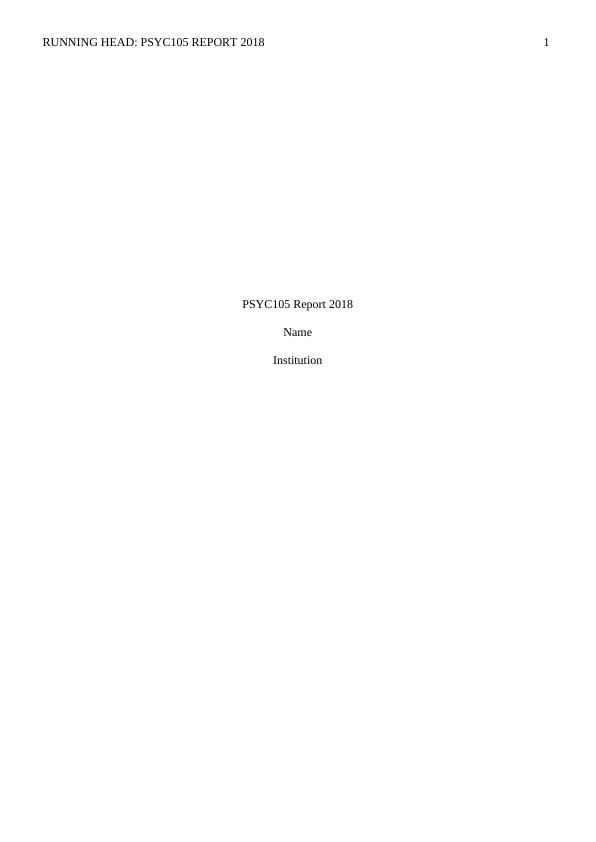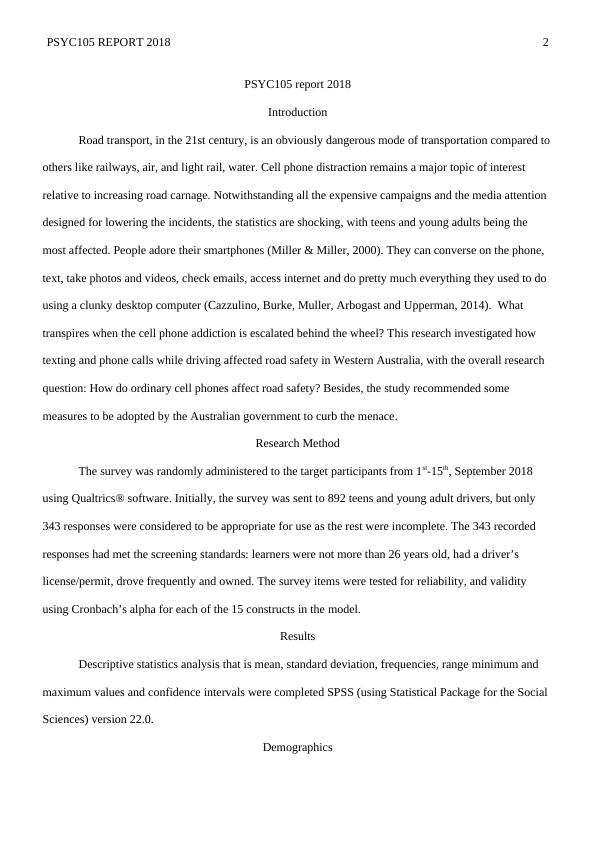Impact of Cell Phone Use on Road Safety in Western Australia
11 Pages4556 Words457 Views
Added on 2023-06-05
About This Document
This report investigates the impact of cell phone use on road safety in Western Australia. It analyzes the results of a survey conducted on teens and young adults and provides recommendations for the Australian government to curb the menace.
Impact of Cell Phone Use on Road Safety in Western Australia
Added on 2023-06-05
ShareRelated Documents
RUNNING HEAD: PSYC105 REPORT 2018 1
PSYC105 Report 2018
Name
Institution
PSYC105 Report 2018
Name
Institution

PSYC105 REPORT 2018 2
PSYC105 report 2018
Introduction
Road transport, in the 21st century, is an obviously dangerous mode of transportation compared to
others like railways, air, and light rail, water. Cell phone distraction remains a major topic of interest
relative to increasing road carnage. Notwithstanding all the expensive campaigns and the media attention
designed for lowering the incidents, the statistics are shocking, with teens and young adults being the
most affected. People adore their smartphones (Miller & Miller, 2000). They can converse on the phone,
text, take photos and videos, check emails, access internet and do pretty much everything they used to do
using a clunky desktop computer (Cazzulino, Burke, Muller, Arbogast and Upperman, 2014). What
transpires when the cell phone addiction is escalated behind the wheel? This research investigated how
texting and phone calls while driving affected road safety in Western Australia, with the overall research
question: How do ordinary cell phones affect road safety? Besides, the study recommended some
measures to be adopted by the Australian government to curb the menace.
Research Method
The survey was randomly administered to the target participants from 1st-15th, September 2018
using Qualtrics® software. Initially, the survey was sent to 892 teens and young adult drivers, but only
343 responses were considered to be appropriate for use as the rest were incomplete. The 343 recorded
responses had met the screening standards: learners were not more than 26 years old, had a driver’s
license/permit, drove frequently and owned. The survey items were tested for reliability, and validity
using Cronbach’s alpha for each of the 15 constructs in the model.
Results
Descriptive statistics analysis that is mean, standard deviation, frequencies, range minimum and
maximum values and confidence intervals were completed SPSS (using Statistical Package for the Social
Sciences) version 22.0.
Demographics
PSYC105 report 2018
Introduction
Road transport, in the 21st century, is an obviously dangerous mode of transportation compared to
others like railways, air, and light rail, water. Cell phone distraction remains a major topic of interest
relative to increasing road carnage. Notwithstanding all the expensive campaigns and the media attention
designed for lowering the incidents, the statistics are shocking, with teens and young adults being the
most affected. People adore their smartphones (Miller & Miller, 2000). They can converse on the phone,
text, take photos and videos, check emails, access internet and do pretty much everything they used to do
using a clunky desktop computer (Cazzulino, Burke, Muller, Arbogast and Upperman, 2014). What
transpires when the cell phone addiction is escalated behind the wheel? This research investigated how
texting and phone calls while driving affected road safety in Western Australia, with the overall research
question: How do ordinary cell phones affect road safety? Besides, the study recommended some
measures to be adopted by the Australian government to curb the menace.
Research Method
The survey was randomly administered to the target participants from 1st-15th, September 2018
using Qualtrics® software. Initially, the survey was sent to 892 teens and young adult drivers, but only
343 responses were considered to be appropriate for use as the rest were incomplete. The 343 recorded
responses had met the screening standards: learners were not more than 26 years old, had a driver’s
license/permit, drove frequently and owned. The survey items were tested for reliability, and validity
using Cronbach’s alpha for each of the 15 constructs in the model.
Results
Descriptive statistics analysis that is mean, standard deviation, frequencies, range minimum and
maximum values and confidence intervals were completed SPSS (using Statistical Package for the Social
Sciences) version 22.0.
Demographics

PSYC105 REPORT 2018 3
Demographic data of the informants was captured under age, gender status of the respondents, license
ownership, driving experience, and use of mobile phones.
As for age, the highest proportion of the respondents were about 19 years old.
AGE
Variable | Obs Mean Std. Dev. Min Max
-------------+---------------------------------------------------------
AGE | 343 19.207 1.682646 17 26
From the findings also in regards to the age parameter, the oldest respondent(s) to have participated in
this study was 26 years old while the youngest was 17 years.
As for data on gender, more females (74.34%) than males (25.07%), participated in the survey.
Sex | Freq. Percent Cum.
------------+-----------------------------------
Male | 86 25.07 25.07
Female | 255 74.34 99.42
Other | 2 0.58 100.00
------------+-----------------------------------
Total | 343 100.00
The survey questions also sought to know about the driving experience and behavior of the respondents.
Years Licensed
Variable | Obs Mean Std. Dev. Min Max
-------------+---------------------------------------------------------
Year licensed| 342 3.018421 1.731034 0 10
From analysis, the collected data revealed that most of the drivers had 3 years of driving. It was noted that
whereas some respondents confessed having 10 years of driving experience, others did not have any
experience in driving.
Asked about the type of licence that was owned, a significant proportion of the participants that they
possessed PS-driving licence (62.10%) and learners licences with a representation of 21%. Yet, some
respondents (about 2%). confessed not having any licence.
Type of license
License type | Freq. Percent Cum.
Demographic data of the informants was captured under age, gender status of the respondents, license
ownership, driving experience, and use of mobile phones.
As for age, the highest proportion of the respondents were about 19 years old.
AGE
Variable | Obs Mean Std. Dev. Min Max
-------------+---------------------------------------------------------
AGE | 343 19.207 1.682646 17 26
From the findings also in regards to the age parameter, the oldest respondent(s) to have participated in
this study was 26 years old while the youngest was 17 years.
As for data on gender, more females (74.34%) than males (25.07%), participated in the survey.
Sex | Freq. Percent Cum.
------------+-----------------------------------
Male | 86 25.07 25.07
Female | 255 74.34 99.42
Other | 2 0.58 100.00
------------+-----------------------------------
Total | 343 100.00
The survey questions also sought to know about the driving experience and behavior of the respondents.
Years Licensed
Variable | Obs Mean Std. Dev. Min Max
-------------+---------------------------------------------------------
Year licensed| 342 3.018421 1.731034 0 10
From analysis, the collected data revealed that most of the drivers had 3 years of driving. It was noted that
whereas some respondents confessed having 10 years of driving experience, others did not have any
experience in driving.
Asked about the type of licence that was owned, a significant proportion of the participants that they
possessed PS-driving licence (62.10%) and learners licences with a representation of 21%. Yet, some
respondents (about 2%). confessed not having any licence.
Type of license
License type | Freq. Percent Cum.

PSYC105 REPORT 2018 4
----------------------+-----------------------------------
None | 6 1.75 1.75
Learners | 74 21.57 23.32
Ps | 213 62.10 85.42
Full or heavy vehicle | 43 12.54 97.96
Motorcycle | 7 2.04 100.00
----------------------+-----------------------------------
Total | 343 100.00
The researcher also collected information about the usage of mobile phones habits.
Use of Cell Phone while driving
How often do YOU use your |
Phone while driving? | Freq. Percent Cum.
---------------------------+-----------------------------------
Three or more times a week | 47 13.70 13.70
Once or twice a week | 93 27.11 40.82
Once or twice a month | 35 10.20 51.02
Less than once a month | 61 17.78 68.80
Never | 107 31.20 100.00
---------------------------+-----------------------------------
Total | 343 100.00
In regards to cell phone use behind the steeling, most respondents reiterated that they at least use phone
once or twice a week (27%) or less than once a month (17%). Still, they were respondents that stated that
they never use phone while driving, that is, 31.2%.
The survey also sought to know about cell phone addiction rates. This was done by studying the rate of
use of phone in other places.
Mobile phone use addiction
How often do you think |
OTHERS use their phone? | Freq. Percent Cum.
---------------------------+-----------------------------------
Three or more times a week | 194 56.56 56.56
Once or twice a week | 118 34.40 90.96
Once or twice a month | 21 6.12 97.08
Less than once a month | 6 1.75 98.83
Never | 4 1.17 100.00
---------------------------+-----------------------------------
Total | 343 100.00
As evident, most of the respondents addicted to phones with majority using them at least three or more
times a week (56.56%) and once or twice a week (34.4%). It is only less than 2% of the respondent that
confessed that they never use phone.
Testing of Hypothesis
----------------------+-----------------------------------
None | 6 1.75 1.75
Learners | 74 21.57 23.32
Ps | 213 62.10 85.42
Full or heavy vehicle | 43 12.54 97.96
Motorcycle | 7 2.04 100.00
----------------------+-----------------------------------
Total | 343 100.00
The researcher also collected information about the usage of mobile phones habits.
Use of Cell Phone while driving
How often do YOU use your |
Phone while driving? | Freq. Percent Cum.
---------------------------+-----------------------------------
Three or more times a week | 47 13.70 13.70
Once or twice a week | 93 27.11 40.82
Once or twice a month | 35 10.20 51.02
Less than once a month | 61 17.78 68.80
Never | 107 31.20 100.00
---------------------------+-----------------------------------
Total | 343 100.00
In regards to cell phone use behind the steeling, most respondents reiterated that they at least use phone
once or twice a week (27%) or less than once a month (17%). Still, they were respondents that stated that
they never use phone while driving, that is, 31.2%.
The survey also sought to know about cell phone addiction rates. This was done by studying the rate of
use of phone in other places.
Mobile phone use addiction
How often do you think |
OTHERS use their phone? | Freq. Percent Cum.
---------------------------+-----------------------------------
Three or more times a week | 194 56.56 56.56
Once or twice a week | 118 34.40 90.96
Once or twice a month | 21 6.12 97.08
Less than once a month | 6 1.75 98.83
Never | 4 1.17 100.00
---------------------------+-----------------------------------
Total | 343 100.00
As evident, most of the respondents addicted to phones with majority using them at least three or more
times a week (56.56%) and once or twice a week (34.4%). It is only less than 2% of the respondent that
confessed that they never use phone.
Testing of Hypothesis

End of preview
Want to access all the pages? Upload your documents or become a member.
